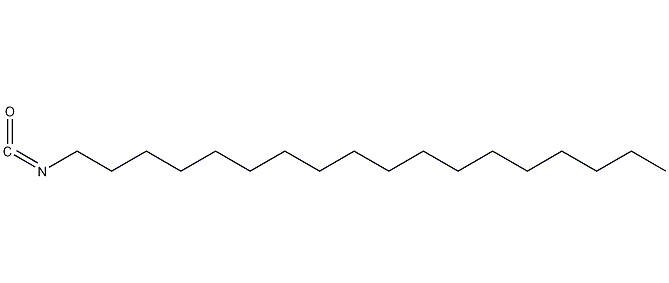Octadecyl Isocyanate Octadecyl Isocyanate


Structural formula
| Business number | 036Z |
|---|---|
| Molecular formula | C19H37NO |
| Molecular weight | 295.50 |
| label |
Stearyl isocyanate, 1-Isocyanato-octadecan, additives, humectant, waterproofing agent, Surfactant, Fungicide |
Numbering system
CAS number:112-96-9
MDL number:MFCD00002041
EINECS number:204-019-7
RTECS number:NR0140000
BRN number:None
PubChem number:24858430
Physical property data
1. Properties: Colorless and slightly turbid liquid.
2. Density (g/mL, 25/4℃): Undetermined
3. Relative vapor density (g/mL, air=1): 0.8625
5. Boiling point (ºC, normal pressure): Undetermined
6. Boiling point (ºC, 5.2kPa): 170
7. Flash point (ºC): 184
Toxicological data
This product is toxic. For its toxicity and protection, please refer to 4,4′-diphenylmethane diisocyanate.
Ecological data
None
Molecular structure data
1. Molar refractive index: 93.83
2. Molar volume (cm3/mol): 339.6
3. Isotonic specific volume (90.2K ): 805.8
4. Surface tension (dyne/cm): 31.7
5. Polarizability (10-24cm3): 37.19
Compute chemical data
1. Reference value for hydrophobic parameter calculation (XlogP): 9.8
2. Number of hydrogen bond donors: 0
3. Number of hydrogen bond acceptors: 2
4. Number of rotatable chemical bonds: 17
5. Number of tautomers: none
6. Topological molecule polar surface area 29.4
7. Number of heavy atoms: 21
8. Surface charge: 0
9. Complexity: 234
10. Number of isotope atoms: 0
11. Determine the number of atomic stereocenters: 0
12. Uncertain number of atomic stereocenters: 0
13. Determine the number of chemical bond stereocenters: 0
14. Number of uncertain chemical bond stereocenters: 0
15. Number of covalent bond units: 1
Properties and stability
This product is toxic. For its toxicity and protection, please refer to 4,4′-diphenylmethane diisocyanate.
Storage method
This product is packed in galvanized iron drums and stored in a clean, dry, cool and ventilated warehouse. Be careful not to be exposed to rain or rain during transportation.Sun exposure. Store and transport according to regulations for flammable and toxic chemicals.
Synthesis method
It is obtained by reacting octadecylamine with phosgene in a chlorobenzene solvent to form octadecylamine amide, which is then decomposed by heating and distilled under reduced pressure.
Purpose
Mainly used as synthetic raw material for printing and dyeing auxiliaries and wool textile softener VS. Can also be used for waterproof fabric surface treatment.
